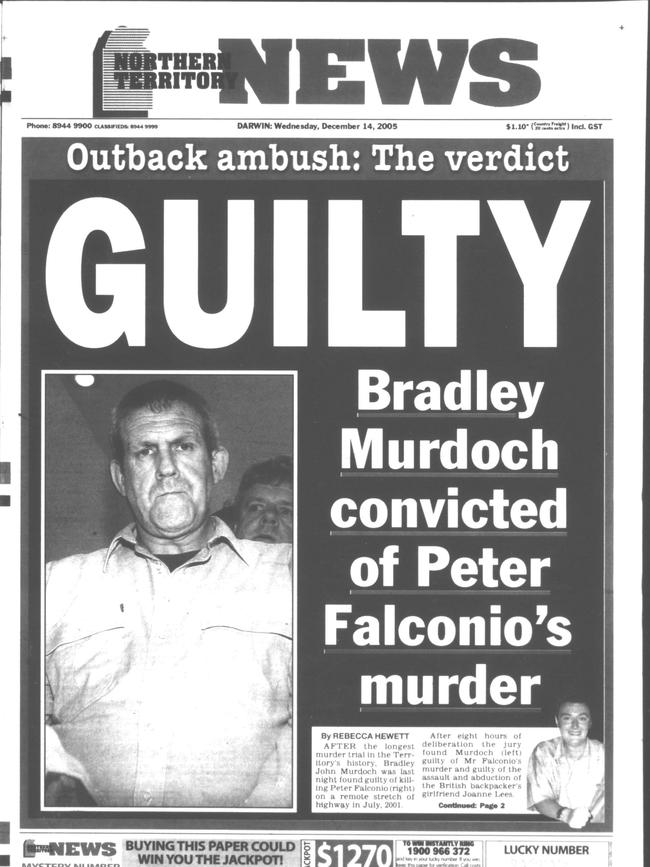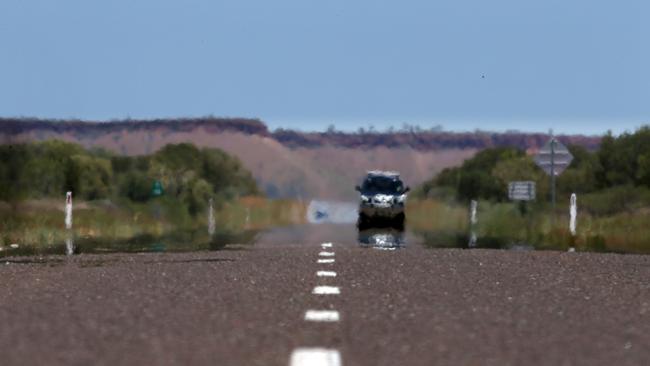Jess Adamson: It’s murder, no matter what the outlandish conspiracists say
It’s been 21 years since the outback murder mystery captivated the world. But some won’t let their conspiracy theories go, writes Jess Adamson.

Opinion
Don't miss out on the headlines from Opinion. Followed categories will be added to My News.
I will never forget the look on Luciano Falconio’s face.
Just days after his son Peter was shot dead on a remote stretch of Northern Territory highway, he visited the outback crime scene – frail, heartbroken and utterly bereft – a picture of grief.
Last Thursday marked the 21st anniversary of the murder of British backpacker Peter Falconio and the abduction of his girlfriend, Joanne Lees. I say murder, because despite the conspiracy theorists still coming up with outlandish ideas of where Peter might be hiding, he’s dead – I saw his blood on the highway all those years ago.


And I’m convinced that Bradley John Murdoch, the man now serving a life sentence for the crimes, is guilty.
I happened to be in Alice Springs on July 14, 2001, where our then premier John Olsen and prime minister John Howard were turning the first sod on the Alice to Darwin rail link.
Cameraman Rob Brown and I took a call from the news director telling us in no uncertain terms to get to Barrow Creek, fast.
We’d never heard of it, but the tiny Barrow Creek Hotel became our home for the next two weeks – the centre point for a nationwide manhunt involving hundreds of police officers, Aboriginal trackers and media from around the world.
Of all the stories I covered in my 24 years as a TV news reporter, this one was the most satisfying.
It’s not often in the fast-moving world of media that you have the privilege of covering a story from the very beginning to the very end, particularly when it spans five years, two jurisdictions and multiple hearings and trials. And this one had more twists and turns than John Platten’s hair in Darwin’s wet season.
Let me quickly refresh your memory of what happened to this young UK couple on the trip of a lifetime. They were travelling in a kombi on the Stuart Highway when Bradley Murdoch pulled alongside them, frantically signalling for Peter to pull over. The decision to do just that cost the 28 year old his life.
Murdoch told Peter he’d seen sparks coming from the rear of their vehicle. He suggested Joanne rev the engine, just to see if it would happen again.
Bang.

A single shot was fired and within seconds Murdoch – all 196cm of him – was standing at the driver’s window with a silver revolver. He manacled Joanne’s wrists behind her back with cable ties and bound her ankles together with tape before bundling her the back of his four-wheel-drive.
Just imagine for one moment how terrified this young woman would have been. She’s in the middle of nowhere, her boyfriend’s not answering her cries for help – and now she’s tied up by a man she’s convinced is going to rape her.
What happened next was one of the most talked about events of the trial. Joanne made her escape from the vehicle and ran into the bushes, her arms still tied behind her back.
But Murdoch had a dog with him. Why on earth didn’t he find her despite searching?
Let me tell you, the dog was a dud when it came to finding things.
It reminded me of some of the “sheep dogs” my dad had on our family farm. One in particular sat in the front seat of the ute while dad ran around the sheep.
Murdoch gave up and hit the highway, with Peter Falconio’s body in the back of his ute. Five hours later, Joanne dashed onto the highway, her arms waving madly in the air.
She was almost run down by two South Australian truckies who had to swerve to miss her. But how did she manage to wave if her hands were tied behind her back, I hear you ask?
Impossible, Murdoch’s defence lawyers argued. They were silenced when Joanne sat on the floor of a packed Darwin courtroom and brought her bound arms from behind her back, under her legs to the front.
It took less than two seconds, but Murdoch could barely watch.
You could have heard a pin drop as she got to her feet.
It makes me sick that this innocent young woman not only had to endure an outback nightmare – but then had to re-enact it time and time again. Just four days after the attack, I stood on the side of the highway as the NT police trucked in the kombi, followed by a vehicle replicating Murdoch’s.
They tied Joanne up and held a gun to her head, desperately trying to jog her memory.
“Joanne lies!” The headlines screamed from the UK tabloids. The British media didn’t believe her story and her demeanour didn’t help.
She had what many called the “Lindy Chamberlain look”, appearing defensive and devoid of emotion.
When Peter’s parents Luciano and Joan and brother Paul arrived in Australia – she seemed distant.
For me, the most powerful moment of the nine-week trial came on November 11, 2005.

There’d been days of argument over whether grainy security video of a tall, stooped man, at a Shell servo was in fact Bradley John Murdoch.
Murdoch denied it was him and was instructed by his defence team to sit up straight in the dock, so as not to look like the man in the video.
That plan went well, until Chief Justice Brian Martin, who successfully prosecuted Bevan Spencer von Einem in the ’80s, announced it was 11am.
It was Remembrance Day and he asked us to stand.
Up until then, Murdoch was always seated before the jury entered the courtroom. They’d never seen him at his full, hulking height.
I was watching the jury as Murdoch reluctantly got to his feet.
There was an audible gasp and an unmissable look of recognition. Deliberate or not, the Remembrance Day gesture was a masterstroke.
Of course, the truck stop video didn’t prove Murdoch’s guilt – but his DNA on Joanne’s T-shirt did.
Murdoch was sentenced to a minimum of 28 years in prison – one year for every year of Peter’s life.
In the Territory, there’s a no body, no parole rule – but given Murdoch’s insatiable appetite for methamphetamines, I don’t believe he’d even remember where on the Tanami Track he left the young backpacker, if in fact that’s where Peter is.
Adelaide criminal lawyer Mark Twiggs was Murdoch’s junior counsel. He recalls Murdoch being “polite and intelligent” with the neatest cursive writing he’d ever seen for a male.
And while Twiggs admits he still doesn’t know exactly what happened on that dark night 21 years ago, he always accepted the umpire’s decision. Conspiracy theorists, it’s time you did the same.





